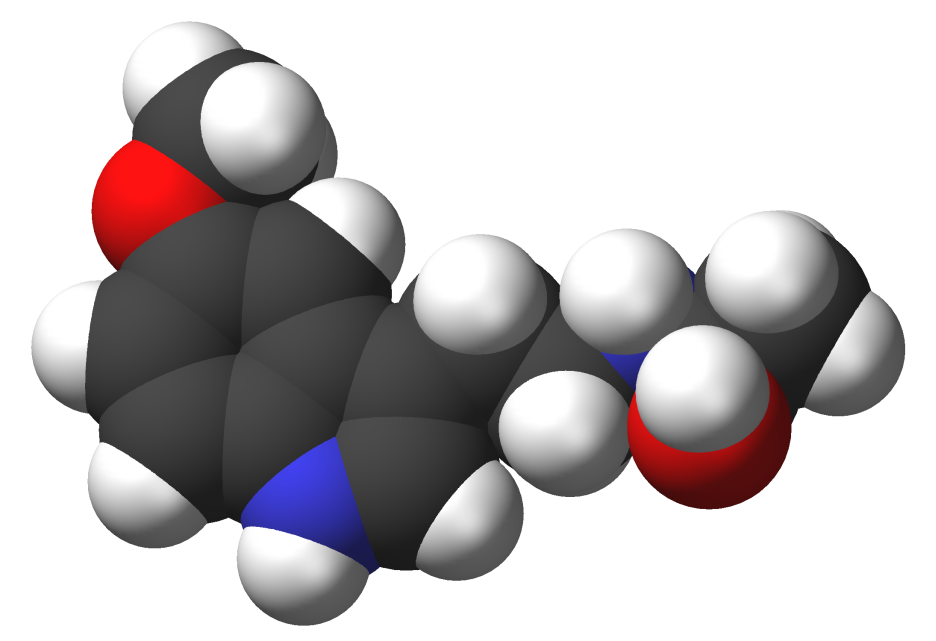Melatonin
Editor-In-Chief: C. Michael Gibson, M.S., M.D. [1]; Associate Editor(s)-in-Chief: Ammu Susheela, M.D. [2]
Disclaimer
WikiDoc MAKES NO GUARANTEE OF VALIDITY. WikiDoc is not a professional health care provider, nor is it a suitable replacement for a licensed healthcare provider. WikiDoc is intended to be an educational tool, not a tool for any form of healthcare delivery. The educational content on WikiDoc drug pages is based upon the FDA package insert, National Library of Medicine content and practice guidelines / consensus statements. WikiDoc does not promote the administration of any medication or device that is not consistent with its labeling. Please read our full disclaimer here.
NOTE: Most over the counter (OTC) are not reviewed and approved by the FDA. However, they may be marketed if they comply with applicable regulations and policies. FDA has not evaluated whether this product complies.
Overview
Melatonin is a hormone that is FDA approved for the treatment of sleep cycle support. Common adverse reactions include hypothermia, somnolence, fatigue.
Adult Indications and Dosage
FDA-Labeled Indications and Dosage (Adult)
- Sleep cycle support.
Off-Label Use and Dosage (Adult)
Guideline-Supported Use
- Cancer: 20 mg ORALLY once daily has been used in clinical trials[1]
- Cancer: up to 40 years, immediate-release, 1.5 mg ORALLY daily
- Cancer: 40 to 60 years, immediate-release, 1.5 to 3 mg ORALLY daily
- Cancer: older than 60 years, immediate-release, 3 to 6 mg ORALLY daily
- Jet lag: 1.5 to 3 mg ORALLY at 11 PM (local time in the destination country) on day 1, 10:30 PM on day 2, and 10 PM on day 3
- Sleep disorder: immediate-release, 5 mg ORALLY 30 minutes prior to time of sleep[2][3] ; up to 10 mg ORALLY daily
- Sleep disorder: extended-release, 2 mg ORALLY 1 to 2 hours before bedtime [4]
Non–Guideline-Supported Use
There is limited information regarding Off-Label Non–Guideline-Supported Use of Melatonin in adult patients.
Pediatric Indications and Dosage
FDA-Labeled Indications and Dosage (Pediatric)
There is limited information regarding FDA-Labeled Use of Melatonin in pediatric patients.
Off-Label Use and Dosage (Pediatric)
Guideline-Supported Use
There is limited information regarding Off-Label Guideline-Supported Use of Melatonin in pediatric patients.
Non–Guideline-Supported Use
There is limited information regarding Off-Label Non–Guideline-Supported Use of Melatonin in pediatric patients.
Contraindications
- Specific contraindications have not been determined.
Warnings
Stop use and seek medical attention if symptoms worsen or persist more than 5 days
Adverse Reactions
Clinical Trials Experience
- Erythema
- Fixed drug eruption
- Fixed-drug eruptions on the glans was described as burning, itching, and sharply marginated, erythematous, vesicular plaques and well-demarcated erosions on the shaft in 2 adult males, occurring within 6 to 8 hours after taking melatonin for jet lag. Lesions dissipated within 10 days.
- Occasional vasodilation has been reported in patients with Parkinson disease treated with a maximum of melatonin 1000 mg/day.
- Pruritus was reported in 1 of 12 elderly subjects with insomnia during therapy with sustained-release melatonin in one study.
Postmarketing Experience
There is limited information regarding Postmarketing Experience of Melatonin in the drug label.
Drug Interactions
Drug interactions have been reported with the following drugs.
Fluvoxamine
Concomitant use can cause central nervous depression.
Nifedipine
Concomitant use can cause increased blood pressure.
Warfarin
Increased risk of bleeding has been noted with concomitant use of warfarin.
Use in Specific Populations
Pregnancy
- Pregnancy Category
- Australian Drug Evaluation Committee (ADEC) Pregnancy Category
There is no Australian Drug Evaluation Committee (ADEC) guidance on usage of Melatonin in women who are pregnant.
Labor and Delivery
There is no FDA guidance on use of Melatonin during labor and delivery.
Nursing Mothers
There is no FDA guidance on the use of Melatonin with respect to nursing mothers.
Pediatric Use
There is no FDA guidance on the use of Melatonin with respect to pediatric patients.
Geriatic Use
There is no FDA guidance on the use of Melatonin with respect to geriatric patients.
Gender
There is no FDA guidance on the use of Melatonin with respect to specific gender populations.
Race
There is no FDA guidance on the use of Melatonin with respect to specific racial populations.
Renal Impairment
There is no FDA guidance on the use of Melatonin in patients with renal impairment.
Hepatic Impairment
There is no FDA guidance on the use of Melatonin in patients with hepatic impairment.
Females of Reproductive Potential and Males
There is no FDA guidance on the use of Melatonin in women of reproductive potentials and males.
Immunocompromised Patients
There is no FDA guidance one the use of Melatonin in patients who are immunocompromised.
Administration and Monitoring
Administration
Monitoring
Physical Findings
- Improvement of sleep in insomnia (eg, reduced sleep latency, longer sleep duration, improved quality of sleep) may indicate efficacy.
- Alleviation of symptoms in jet lag (eg, correction of disturbed sleep, reduced daytime tiredness) may indicate efficacy.
IV Compatibility
There is limited information regarding IV Compatibility of Melatonin in the drug label.
Overdosage
There is limited information regarding Chronic Overdose of Melatonin in the drug label.
Pharmacology

| |

| |
Melatonin
| |
| Systematic (IUPAC) name | |
| N-[2-(5-methoxy-1H-indol-3-yl)ethyl] acetamide | |
| Identifiers | |
| CAS number | |
| ATC code | N05 |
| PubChem | |
| DrugBank | |
| Chemical data | |
| Formula | Template:OrganicBox atomTemplate:OrganicBox atomTemplate:OrganicBoxTemplate:OrganicBoxTemplate:OrganicBoxTemplate:OrganicBoxTemplate:OrganicBoxTemplate:OrganicBoxTemplate:OrganicBoxTemplate:OrganicBoxTemplate:OrganicBoxTemplate:OrganicBoxTemplate:OrganicBoxTemplate:OrganicBox atomTemplate:OrganicBoxTemplate:OrganicBox atomTemplate:OrganicBoxTemplate:OrganicBoxTemplate:OrganicBoxTemplate:OrganicBoxTemplate:OrganicBoxTemplate:OrganicBoxTemplate:OrganicBox |
| Mol. mass | 232.278 g/mol |
| SMILES | & |
| Pharmacokinetic data | |
| Bioavailability | 30 – 50% |
| Metabolism | Hepatic via CYP1A2 mediated 6-hydroxylation |
| Half life | 35 to 50 minutes |
| Excretion | Renal |
| Therapeutic considerations | |
| Pregnancy cat. |
? |
| Legal status | |
| Routes | In humans: orally, as capsules, tablets, or liquid, sublingually, or as transdermal patches. In lab animals: also injection. |
Mechanism of Action
- The binding of melatonin to melatonin receptors activates a few signaling pathways.[5]
- MT1 receptor activation inhibits the adenylyl cyclase and its inhibition causes a rippling effect of non activation; starting with decreasing formation of cyclic adenosine monophosphate (cAMP), and then progressing to less protein kinase A (PKA) activity, which in turn hinders the phosphorylation of cAMP responsive element-binding protein (CREB binding protein) into P-CREB.[4] MT1 receptors also activate phospholipase C (PLC), affect ion channels and regulate ion flux inside the cell.[5][6][7]The binding of melatonin to MT2 receptors inhibits adenylyl cyclase which decreases the formation of cAMP.[7]
- As well it hinders guanylyl cyclase and therefore the forming of cyclic guanosine monophosphate (cGMP). Binding to MT2 receptors probably affects PLC which increases protein kinase C (PKC) activity. Activation of the receptor can lead to ion flux inside the cell.[7]
- When melatonin receptor agonists activate their receptors it causes numerous physiological processes.[7][8]
- MT1 and MT2 receptors may be a target for the treatment of circadian and non circadian sleep disorders because of their differences in pharmacology and function within the SCN. The SCN is responsible for maintaining the 24 hour cycle which regulates many different body functions ranging from sleep to immune functions.[9]
- Melatonin receptors have been identified in the cardiovascular system. Evidence from animal studies points to a dual role of melatonin in the vasculature.
- Activation of MT1 receptors mediates vasoconstriction and the activation of MT2 receptors mediates vasodilation. Melatonin is involved in regulating immune responses in both human and animals through activation of both MT1 and MT2 receptors.
- MT1 and MT2 receptors are widespread in the eye and are involved in regulating aqueous humor secretion, which is important for glaucoma, and in phototransduction. This is not a complete list since many of the possible processes need further confirmation
Structure
There is limited information regarding Melatonin Structure in the drug label.
Pharmacodynamics
There is limited information regarding Pharmacodynamics of Melatonin in the drug label.
Pharmacokinetics
There is limited information regarding Pharmacokinetics of Melatonin in the drug label.
Nonclinical Toxicology
There is limited information regarding Nonclinical Toxicology of Melatonin in the drug label.
Clinical Studies
There is limited information regarding Clinical Studies of Melatonin in the drug label.
How Supplied
There is limited information regarding Melatonin How Supplied in the drug label.
Storage
There is limited information regarding Melatonin Storage in the drug label.
Images
Drug Images
{{#ask: Page Name::Melatonin |?Pill Name |?Drug Name |?Pill Ingred |?Pill Imprint |?Pill Dosage |?Pill Color |?Pill Shape |?Pill Size (mm) |?Pill Scoring |?NDC |?Drug Author |format=template |template=DrugPageImages |mainlabel=- |sort=Pill Name }}
Package and Label Display Panel
{{#ask: Label Page::Melatonin |?Label Name |format=template |template=DrugLabelImages |mainlabel=- |sort=Label Page }}
Patient Counseling Information
Take 15 minutes before meals.
- Adults and children 12 years and older 20 drops twice a day in a little water. Hold in the mouth for about 30 seconds then swallow.
- Children between 12 years and 6 years of age 10 drops twice a day in a little water. Hold in the mouth for about 30 seconds then swallow.
- Children under 6 years
Precautions with Alcohol
- Alcohol-Melatonin interaction has not been established. Talk to your doctor about the effects of taking alcohol with this medication.
Brand Names
- GUNA-MELATONIN ®[10]
Look-Alike Drug Names
There is limited information regarding Melatonin Look-Alike Drug Names in the drug label.
Drug Shortage Status
Price
References
The contents of this FDA label are provided by the National Library of Medicine.
- ↑ Wang YM, Jin BZ, Ai F, Duan CH, Lu YZ, Dong TF; et al. (2012). "The efficacy and safety of melatonin in concurrent chemotherapy or radiotherapy for solid tumors: a meta-analysis of randomized controlled trials". Cancer Chemother Pharmacol. 69 (5): 1213–20. doi:10.1007/s00280-012-1828-8. PMID 22271210.
- ↑ Dahlitz M, Alvarez B, Vignau J, English J, Arendt J, Parkes JD (1991). "Delayed sleep phase syndrome response to melatonin". Lancet. 337 (8750): 1121–4. PMID 1674014.
- ↑ Warman GR, Pawley MD, Bolton C, Cheeseman JF, Fernando AT, Arendt J; et al. (2011). "Circadian-related sleep disorders and sleep medication use in the New Zealand blind population: an observational prevalence survey". PLoS One. 6 (7): e22073. doi:10.1371/journal.pone.0022073. PMC 3138759. PMID 21789214.
- ↑ Wade AG, Ford I, Crawford G, McConnachie A, Nir T, Laudon M; et al. (2010). "Nightly treatment of primary insomnia with prolonged release melatonin for 6 months: a randomized placebo controlled trial on age and endogenous melatonin as predictors of efficacy and safety". BMC Med. 8: 51. doi:10.1186/1741-7015-8-51. PMC 2933606. PMID 20712869 PMID: 20712869 Check
|pmid=value (help). - ↑ 5.0 5.1 Rivara S, Mor M, Bedini A, Spadoni G, Tarzia G (2008). "Melatonin receptor agonists: SAR and applications to the treatment of sleep-wake disorders". Curr Top Med Chem. 8 (11): 954–68. PMID 18673165.
- ↑ Pandi-Perumal SR, Trakht I, Srinivasan V, Spence DW, Maestroni GJ, Zisapel N; et al. (2008). "Physiological effects of melatonin: role of melatonin receptors and signal transduction pathways". Prog Neurobiol. 85 (3): 335–53. doi:10.1016/j.pneurobio.2008.04.001. PMID 18571301 PMID 18571301 Check
|pmid=value (help). - ↑ 7.0 7.1 7.2 7.3 Dubocovich ML, Delagrange P, Krause DN, Sugden D, Cardinali DP, Olcese J (2010). "International Union of Basic and Clinical Pharmacology. LXXV. Nomenclature, classification, and pharmacology of G protein-coupled melatonin receptors". Pharmacol Rev. 62 (3): 343–80. doi:10.1124/pr.110.002832. PMC 2964901. PMID 20605968 PMID 20605968 Check
|pmid=value (help). - ↑ Witt-Enderby PA, Bennett J, Jarzynka MJ, Firestine S, Melan MA (2003). "Melatonin receptors and their regulation: biochemical and structural mechanisms". Life Sci. 72 (20): 2183–98. PMID 12628439 PMID 12628439 Check
|pmid=value (help). - ↑ Dubocovich ML (2007). "Melatonin receptors: role on sleep and circadian rhythm regulation". Sleep Med. 8 Suppl 3: 34–42. doi:10.1016/j.sleep.2007.10.007. PMID 18032103 PMID 18032103 Check
|pmid=value (help). - ↑ ": GUNA-MELATONIN - melatonin solution/ drops".
{{#subobject:
|Label Page=Melatonin |Label Name=Melatonin.jpg
}}
{{#subobject:
|Label Page=Melatonin |Label Name=Melatonin001.png
}}
{{#subobject:
|Label Page=Melatonin |Label Name=Melatonin002.png
}}